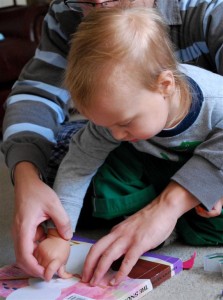To consistently express the nurturing and attentive love that Attachment Parenting is all about is no easy task when you’re out of your mind sleep-deprived, weary of toddler tantrums and stretched to your capacity to care for your family, your house, your work, and maybe — if you’re lucky — yourself. I’ve teetered on burn-out quite a bit over the last several months and was delighted recently to learn some quick tricks for shifting out of my “this is too hard” mindset and into total gratitude for my life and my ability to create something new and magical for myself and my family every day.
 Knowing how well these tricks can work for me during grumpy moments (when I remember to access them), I’m inspired to guide my 3 year-old in giving them a try when she gets emotionally stuck too. I can remind her of how she felt in this picture when her arms were outstretched in pure, unfettered bliss and encourage her to replay this physical state or others that she likes to access the joyful emotions that accompanied them.
Knowing how well these tricks can work for me during grumpy moments (when I remember to access them), I’m inspired to guide my 3 year-old in giving them a try when she gets emotionally stuck too. I can remind her of how she felt in this picture when her arms were outstretched in pure, unfettered bliss and encourage her to replay this physical state or others that she likes to access the joyful emotions that accompanied them.
As a leader of tropical yoga retreats in Hawaii and Mexico, I’ve researched numerous resorts and retreat centers to find the locations most suitable for the clientele I want to draw. Retreat centers range from the rustic to the luxurious, from mountain to beach settings, and from remote to city center. Below are some considerations for what to look for in your search for the ideal yoga retreat. Click here if you want to find out more about yoga resort and adventure.
Do you want to retreat into yourself or have a social outdoor adventure? Some centers have several groups intermingling at meals, at the pool, dance parties, or are centrally located in a town with street noise, music, etc. Others have space for only one group, or are in remote locations with no cars in sight. Many are in between. I’ve found that even if there are plenty of extra activities offered, one can always choose to abstain, stay quiet, take naps, receive bodywork, etc, as long as the setting is tranquil.
Courtesy of Helen Attridge of Inner Wisdom Coaching, here are three amazing mood shifting strategies.
1) Change your physiology. When you’re angry at life, how does it feel in your body? What do your shoulders do? How do you breathe? What happens to your forehead, your mouth, your jaw….? Now think about your physical state when you’re feeling your favorite emotion. My favorite emotional state is a combination of inspired and secure. When I feel this way, I feel energetic, powerful, open, and tapped into Life. My chest is open versus hunched, my face is bright and content versus scrunched or clenched and my breathing comes easy.
To find the emotional state that matches the physical state, start with the latter. Stretch. Walk outside. Dance. Practice Yoga. Check out this great article from Fit Yoga Magazine posted in Yoga in Tribeca on how to impact the way you think and feel and create through direct manipulation of the body.
2) Check in on your focus and your beliefs in that moment. Last week I received a rejection letter from a company I was really excited about working for and my mind really struggled to stay positive. The thoughts and questions that clouded my head, together with other self-deprecating slams were, “Why is this not happening? and “It’s going to take forever.” Feeling and expressing disappointment is healthy and natural of course. Keeping my mental focus there and maintaining the ridiculous belief that anything takes “forever” would energetically block opportunities, connections and any number of other wonderful things that cross my path.
3) Change the question. If you hear any version of “What’s wrong with me?” or “Why can’t I figure this out?” in your head, get conscious of it, recognize that no valuable answer comes from a negatively oriented question, and try asking a different set of questions like:
- “What’s next?”
- “How can we have fun?”
- “What am I grateful for right now?”
- “What am I willing to do to create a new reality?”
- “How can we make this an amazing adventure?”
- “What is perfect about this moment?”
- “What am I learning?”
The transformation from Grumperella back to Sweet Loving AP Mama is great!
What tricks do you have for maintaining your ability to provide consistent and loving care when you’re feeling tired or grouchy? I’d love to hear them.
Monica Cravotta lives in Austin, Texas with her husband and two daughters, ages 3 and 1. She blogs at AttachmentMama.com.
 asked by many bunny family members what he wanted to be when he grew up. Did he want to be a fireman? A policeman? A doctor? A vet? The bunny just kept shaking his head, he didn’t want to be any of those things. In the end of the book the little bunny states that he wants to be a daddy bunny.
asked by many bunny family members what he wanted to be when he grew up. Did he want to be a fireman? A policeman? A doctor? A vet? The bunny just kept shaking his head, he didn’t want to be any of those things. In the end of the book the little bunny states that he wants to be a daddy bunny. 
 When I was 11 or 12, my mom took me shopping for a new bathing suit. When she suggested a style that was popular at that time, a one-piece tank suit with a large circle cut out on the stomach area, I told her, “I’m too fat too wear one of those.” I have no idea why this particular memory sticks in my head, but I also remember how upset my mom was with what I said. I didn’t understand her distress then, but I certainly understand it now.
When I was 11 or 12, my mom took me shopping for a new bathing suit. When she suggested a style that was popular at that time, a one-piece tank suit with a large circle cut out on the stomach area, I told her, “I’m too fat too wear one of those.” I have no idea why this particular memory sticks in my head, but I also remember how upset my mom was with what I said. I didn’t understand her distress then, but I certainly understand it now. important they are to you. Give them affection without limit, without reservations, and without excuse. Pay as much attention to them as you can, regardless of mood or circumstance. Let them know you’re delighted to be with them, that you care about them no matter what happens. This basic posture is completely different from praise, which is doled out as a response to something a child does.
important they are to you. Give them affection without limit, without reservations, and without excuse. Pay as much attention to them as you can, regardless of mood or circumstance. Let them know you’re delighted to be with them, that you care about them no matter what happens. This basic posture is completely different from praise, which is doled out as a response to something a child does.

 Knowing how well these tricks can work for me during grumpy moments (when I remember to access them), I’m inspired to guide my 3 year-old in giving them a try when she gets emotionally stuck too. I can remind her of how she felt in this picture when her arms were outstretched in pure, unfettered bliss and encourage her to replay this physical state or others that she likes to access the joyful emotions that accompanied them.
Knowing how well these tricks can work for me during grumpy moments (when I remember to access them), I’m inspired to guide my 3 year-old in giving them a try when she gets emotionally stuck too. I can remind her of how she felt in this picture when her arms were outstretched in pure, unfettered bliss and encourage her to replay this physical state or others that she likes to access the joyful emotions that accompanied them.